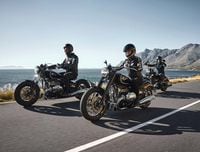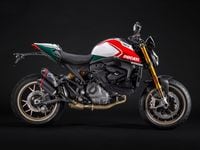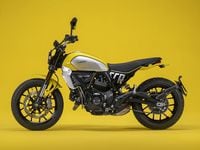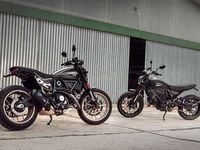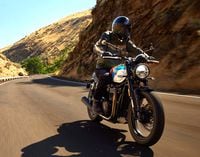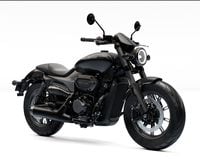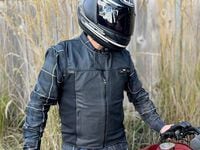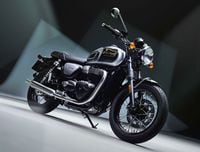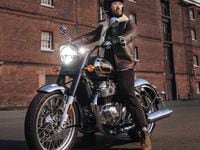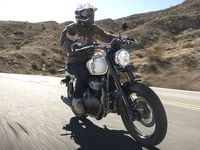This article was originally published in the August 1998 issue of Motorcycle Cruiser.
“Send us the best, coolest motorcycle you’ve got.”
That was the request Motorcycle Cruiser conveyed to the eight major makers of big street bikes that count cruisers among their models. "We want your flagship cruiser," we told them. There were some conditions. We wanted unmitigated cruisers, not touring cruisers. That meant no Harley Road Kings or Kawasaki Nomads. For some manufacturers, the choice was clear. BMW only makes one cruiser model, the R1200C. Nor was there any doubt about which model Moto Guzzi would send. The V11 EV is the Italian maker's solitary cruiser. Suzuki's new 1500 Intruder LC was its obvious choice, and that's what it selected. Kawasaki's choice was also clear-cut; it sent the Vulcan 1500 Classic. We wondered whether Honda would choose the beautifully crafted 1100 Aero V-twin or the big six-cylinder Valkyrie. We got the six Triumph makes three versions of its 900-triple that fit—at least loosely—in the cruiser category, and it sent the Thunderbird, on which the other two are based. We knew Yamaha would offer up a Royal Star; it offered the new Silverado. There are eight renditions of Harley's big-bore twin that would qualify, and after ascertaining that the Road King wasn't eligible, Harley elected to send the Heritage Softail Springer—its most nostalgic and expensive cruiser.
Obviously, different companies have very diverse ideas about what makes the perfect cruiser. There were three tandem V-twins, Moto Guzzi's across-the-frame V-twin, an opposed twin, one vertical triple, a V-four and an opposed six. We had three different front suspension configurations (four if you count inverted telescopics as a different arrangement) and five variations on rear suspension.
We wanted to make these flagship cruisers prove themselves in more than basic boulevard duty. So in addition to putting them through their paces during day and night urban service, we laid out a five-day ride through California and Nevada with a variety of roads. Along the way we threw in special tests where, for example, each rider ran them all over the same section of curving road, practiced panic braking on the same piece of pavement, or made them all creep along in tight quarters in a parking lot.
Before you can ride it, you must start it. We don’t miss the days of kickstarters a bit when we see how easily these machines come to life. Fuel injection makes it particularly easy to start the BMW and Guzzi, cold. The Honda and Triumph provide handlebar-mounted chokes, but the rest require you to grope around on the left side of their engines for the choke knobs.
There were a couple of mornings when they had to start after sitting overnight in temperatures around freezing. It was hard to tell whether the cold-bloodedness of a few bikes (the Harley and Suzuki) was due to California emissions standards. Two bikes, the Moto Guzzi, and to a lesser degree, the BMW, lean to the right when the throttle is blipped at a stop. You only notice this when the engine is allowed to spin freely (when it’s disengaged from the transmission).
When you are ready to roll, the first thing you will experience is the clutch. We liked the clutches on the Silverado, Thunderbird, V11, Valkyrie and Vulcan. We wished for improvement on the Harley and BMW.
Then there is the Intruder clutch. “I can’t believe a Japanese company would make a clutch like this,” said one rider. The clutch engages at the very end of its travel, when most fingers have very little purchase on it. When the revs are up, it engages abruptly. In stop-and-go traffic on a slippery Las Vegas interstate, it had one experienced rider spinning the rear wheel unexpectedly. After you ride it in traffic for awhile, the awful clutch taints the entire bike. This feature alone probably brought everyone’s rating down by at least one full star. Though you could file down some of the mechanism to make it engage closer to the handlebar, we have no fix for the unforgiving engagement.
Clunky drivetrains were detriments on the BMW and Harley. The BMW in particular has some lash. The Valkyrie transmission got top marks in all areas of drivetrain performance—shifting, ratio staging and absence of lash. The Star, T-Bird and Vulcan also shifted well. The poorly configured heel-toe shifting on the V11 made it a solid last choice in terms of gear changes, though the Suzuki—which missed some shifts for most riders—was only marginally better. The BMW also attracted some gripes about shifting.
Low-speed power characteristics varied considerably. The Honda and Triumph have little flywheel effect, and the Guzzi has a lot. All the V-twins have substantial flywheels, with the BMW and Yamaha in the middle. Flywheel effect can be good or bad. If the clutch is grabby, as on the Intruder, it’s a liability. If the throttle is abrupt, as on the 1200C and Harley, it can help smooth it out. Our riders were least impressed by the Harley’s throttle response and control, but liked the way the Honda, Kawasaki and Triumph behaved when the throttle was prodded. The Honda and Triumph got high marks for all areas of engine performance, save perhaps fuel mileage.
In terms of fuel economy, the Harley was clearly king, as the specification chart shows. It was the only bike to regularly turn in highway mileage in excess of 50 mpg. The Valkyrie sucked up the largest amount of the petroleum elixir we pumped into all of the bikes. However, since it also has the largest fuel tank, the Honda still offers respectable range. Large tanks also give the 1200C, Royal Star and V11 long legs. The Thunderbird is the bike most likely to make you walk if you have a long distance between gas stations.
The spec chart also tells the story about full-bore acceleration. Some riders were surprised that the “little” Triumph dusted all but the Valkyrie at the dragstrip and—thanks in part to a gearing advantage—ran away from the rest in our top-gear roll-on.
Of course, by the time we got to the strip, the Triumph’s top-gear acceleration edge was no longer a secret. We had conducted several side-by-side roll-on races, including some at high altitude. When we were more than a mile up, the Triumph continued to shine. However, the Honda and particularly the Yamaha suffered. When we did roll-ons on a steep hill at 7000 feet above sea level starting from 30 mph, the Yamaha fell flat on its face. It had to be downshifted to fourth before it would pull at all. The others were all able to pull in top-gear, and the fuel injection of the BMW and Moto Guzzi gave them an edge, since they were able to correct the mixture for the altitude.
Closer to sea level, the Yamaha was able to recover enough to pull away from the Harley in roll-ons but, as one tester noted, “It’s pretty wimpy for a four-cylinder.” The Kawasaki was slowest in all-out acceleration, but bested the Harley, Suzuki, and Yamaha in top-gear acceleration. The Guzzi also did well, running third-quickest through the quarter-mile and fourth in top-gear-only acceleration.
After five days on the bikes, everyone had definite opinions about which bikes were comfortable and which weren’t. Not that we all agreed. Size does matter here. Bigger riders were more likely to give the Intruder’s roomy ergonomics high marks, while shorter riders were apt to find it too big for comfort and preferred the Thunderbird’s seat-bar-peg relationship. However, there were some points of agreement. Everyone liked the ergonomics of the Valkyrie and Vulcan Classic. The rider’s stance on the Valkyrie is more standard bike-like, since the footpegs are back behind the cylinders. The Vulcan has a more traditional, feet-forward cruiser position. The BMW has a similar footpeg restriction, and the Thunderbird is definitely arranged with the pegs rearward, almost under the rider. For all but the biggest riders, the Intruder’s floorboards were too far forward. The V11’s bent most riders into the least comfortable riding position of these eight bikes. Only one rider liked the posture induced on the Guzzi.
Some were also surprised by differences in perception and reality on the bikes. “I always thought that Hogs were giants,” reflected one rider, “but it seems small after riding the others.” Others said they expected the Valkyrie to be intimidating but discovered a bike that was a good fit and easy to manage.
Handlebar bend was emphasized during rides into a headwind. In those instances, the low, comparatively narrow handlebar of the Triumph was favored because you could lean into the wind and minimize the pressure on your arms and shoulders. The Kawasaki and Yamaha were more comfortable than the others in this situation, but the Harley and Moto Guzzi got low marks. We’d make a windshield a must-have item for long rides on those bikes or the BMW.
The shape of the Guzzi’s saddle contributes to its uncomfortable riding position, because it forces a somewhat cramped position. The V11’s seat foam—which feels more like wood 100 miles down the road—prompted testers to rank that saddle dead last, behind even the BMW and Harley seats which also amassed low rankings, though one rider liked them both. The rail running around the the Harley’s rider saddle rubbed some riders uncomfortably.
Taller riders were likely to give the Triumph saddle low marks, both for shape and foam comfort. On the other hand, they were particularly impressed by the Suzuki’s flat, roomy saddle, which remains comfortable under a heavy rider for many hours. Shorter riders were more likely to rank the Honda saddle as their favorite, and it ranked with the Intruder saddle as the best stock seat here. Kawasaki’s seat was rated third, ahead of the Yamaha.
One feature of the BMW which drew praise was its fold-up passenger pad. While inadequate for a passenger for more than a brief ride, it folds up to act as a rider backrest. Not everyone found it particularly useful, but those who did liked it a great deal.
The Valkyrie racked up top marks for suspension comfort, giving the best ride over all sorts of bumps. The Triumph had the second most compliant ride while the Guzzi ranked third. The revised suspension of the Royal Star put it ahead of the Kawasaki and Suzuki, both of which were deemed satisfactory. However, our testers gave low marks to the bump-stopping qualities of the BMW and Harley. Both bikes suffer from limited travel and harsh rides at the rear more than the front. While you can replace a bad seat, modify harsh suspension, and adjust or change handlebars and saddle to modify ergonomics, there isn’t much you can do about a bike that vibrates too much. Every rider regarded the Valkyrie as exceptionally smooth. Although one rider complained about vibration on the Kawasaki, the others gave it top marks, ranking it with the smooth Triumph and ahead of the Suzuki. There were mixed reports for the Moto Guzzi and Yamaha, which some riders called smooth and others found irritating. Most riders said the BMW was “buzzy,” and the Harley got universally low marks because of its heavy vibration.
Size also makes a difference in hands. Smaller hands were uncomfortable on the oversized grips of most of the bikes, and one rider complained that they were mostly too small. However, the slippery leather grip covers of the BMW drew criticism because they forced you to squeeze harder to hold on to the bike, particularly when gripping the high handlebar against strong wind pressure.
Every ride does indeed start in first gear, and the ease of handling at creeping speed influences how confident you feel about a bike. There is more to low-speed manageability than steering geometry, however. Ergonomics play a big part. If one handlebar end is in your gut and the other end is about an arm-and-a-half’s reach away, making a full-lock turn at a creeping pace is sure to be difficult. The drivetrain also plays a role, because abrupt low-speed throttle response or clutch engagement can make tight, low-speed maneuvers tenuous as well.
Those factors, rather than simple mass, are what prompted poor marks for the Suzuki in low-speed handling. Smaller riders especially had trouble with the long reach to the handlebar, but the abrupt clutch engagement pushed everyone’s opinion down and earned it the nickname, Water Buffalo. Light weight, responsive steering and shorter handlebars made the BMW and Triumph the preferred mounts when tight turns at a crawling speed were on the menu. Everyone also felt comfortable on the Honda and Kawasaki, and the rest of the bikes were judged adequately controllable when barely moving.
We spent time on a variety of winding roads, ranging from fast, smooth desert highways to tight, sometimes bumpy, mountain roads. But no matter what the road threw at us, the Valkyrie was the favorite when the map got squiggly. With the best suspension, predictable and responsive steering, great stability, and—for those who wanted to corner aggressively—good cornering clearance, it was the bike of choice on meandering roads.
“You’re always in complete control on the Valkyrie,” enthused one rider.
“How can such a big bike feel so surefooted?” someone else wanted to know.
“Handles like a dream,” said another (who has never ridden a dream, obviously). “Admittedly, a 700-pound dream, but a dream nonetheless.”
“It kicks butt in the corners,” concluded a third.
Winding roads also brought out the strengths of the Moto Guzzi and Triumph. The V11 got to show off its great suspension, good clearance, predictable steering response and solid chassis, although ergonomics and discomfort with the linked brakes kept most riders from being comfortable enough to be as aggressive as they were on some of the other bikes. The Triumph suffered from slightly soft suspension up front and a shortness of damping in the rear. But precise, very responsive steering, good cornering clearance and a stiff chassis still offered plenty of fun on winding roads. “It feels like a 600 sportbike compared to some of these,” read one tester’s notes.
The “some of these” would be the Harley and Suzuki, neither of which feels comfortable while cornering. The Harley scored lowest in overall handling because of its harsh suspension, heavy steering, and limited cornering clearance. Even though you have to approach corners more slowly than on the other bikes, “you really have to put your shoulder into it to make it turn,” one member of the party noted.
The Suzuki, while requiring a bit less effort to turn, never lets you forget its bulk. Its suspension feels overworked, and the bike never feels fully planted in corners. “It’s big and awkward,” was the way a smaller rider summed it up. Certainly, neither the Heritage Springer nor the Intruder 1500 is a suitable choice for riders with an even modest interest in brisking through a corner.
The Vulcan also suffers because of its underdamped suspension and tendency to wallow in corners. However, it feels much more responsive and offers greater confidence than the Suzuki. Overall, it was on par with the Yamaha, which has better suspension and feels more stable while cornering, but provides less cornering clearance and requires slightly more effort.
Great brakes may not sell many cruisers, but pay attention to them. Every now and again, your brakes and your ability to use them to their full extent can make the difference between an adrenaline rush and a trip to the hospital.
Two of our flagships possess very good brakes. One of them is the Valkyrie, which offers excellent power and control coupled with better-than-average traction and a stable chassis. Although its brakes were a bit abrupt, the 1200C made up for that with its optional anti-lock braking system (ABS). On that ultra-slick section of interstate that had other riders sweating when traffic suddenly stopped, the BMW pilot could brake hard with confidence, knowing his tires wouldn’t slide. Yes, you can stop harder if you brake just short of where the tires lock up than you can if the ABS releases the brake pressure for a nano-second, but that requires plenty of practice and a good appraisal of pavement traction. The beauty of ABS is that it allows you to guess wrong without penalty. It can also adjust instantly to changing pavement conditions. Is that oil on the pavement, or just a glare? No worries, just hold the brakes on and let ABS sort it out.
Close to those two bikes are the Royal Star and the Thunderbird. Good power and traction were undermined by a mushy front brake on our Triumph. The Star, the heaviest bike here, takes a stronger pull up front and most of us felt the rear brake pedal’s position, relative to the floorboard, was slightly awkward. However, the power is there and control is good. The front brake lever includes a screw to adjust its engagement point.
The Vulcan also has an adjustable front brake lever, though it uses a cam-type adjustment. The Vulcan Classic delivers less power than the Yamaha, but offers the most comfortable brake-pedal arrangement of any other floorboard-equipped bike in our experience. Higher effort for the front brake and a slightly more awkward floorboard/ pedal arrangement places the Heritage Springer next, just ahead of the Suzuki. Most riders found the Intruder’s front brake slightly mushy or underpowered. And the rear brake pedal position—though better than the Harley—was slightly less convenient and controllable than that of the Vulcan’s pedal. Despite its cam-type adjuster, the Intruder 1500’s lever was a long reach for small hands.
What the clutch is to the Suzuki, brakes are to the Moto Guzzi. The beauty of integrated braking is that you can get smooth stops braking using just the foot pedal, which applies both front and rear brakes. Aside from the fact that you must lift your heel off the floorboard and put it on the mini-peg (or nubbin) to operate the pedal, the system can work well in normal stops, when the bike stops smoothly with a minimum of dive. But nobody liked it in panic stops or even hard stops. The triple four-piston caliper brakes are quite powerful, and modulating and balancing front and rear with your foot is no mean feat on a slippery surface. Those of us who dared to attempt hard stops found it very difficult to get any sense of how much supplementary handlebar-lever pressure to apply, even on good dry pavement.
This system might indeed be superior for riders who have never bothered to learn to use front brakes. But experienced riders will have a few months, at the very least, before they can get the braking they would with separate brake circuits. Furthermore, in the words of one rider, “Guzzi took a bad thing and screwed it up with that floorboard arrangement.” To have any control of pedal pressure at all, your heel must rest on the nubbin, which places your right leg awkwardly and uncomfortably high. But in order to keep a halfway reasonable reaction time to what is your primary braking control, your foot has to be there; so you ride around in traffic with your foot stuck up on the little peg. God help the rider whose foot is on the floorboard when a truck turns in front of him.
The brakes also made it hard to enjoy the Guzzi’s suspension and steering on a twisty road, since no one wanted to have to use the brakes hard in a corner. Unless the corner was familiar, most riders slowed the V11 down significantly before entering. The V11’s brakes are one of those major flaws that blemished the entire bike for everyone.
Three bikes gathered the majority of the covetous glances and acclaim from folks who encountered our group. Some liked the Heritage simply because it was a Harley. A few people thought it was an older bike, but the retro looks of the Triumph suckered even more of the uninitiated. The Thunderbird’s looks drew positive commentary, in part because it was unique and in part because its green color popped out of the field.
The bike that won the most plaudits was the Silverado. Despite its reserved paint scheme, the Yamaha’s quality and detailing stood out to everyone who saw them all. The Royal Stars have set the standard for finish quality since their introduction, but the Silverado hits to an even higher level with its tasteful use of beautifully sculpted billet. “Now that is what a cruiser should look like,” exalted one fellow motor-cyclist we met on our travels.
The love-it-or-hate-it reception for the BMW hasn’t changed. Sidewalk stylists and our testers were split on whether the bike is a stroke of genius or an eyesore. The Valkyrie gets a similarly split reaction, but much more muted. In general, people tend to pick on pieces of the Valkyrie that annoy them—that radiator hose, for example.
Most people like the lines, detailing and finish of the Vulcan Classic, though a few regard it as a Harley clone. “Like a Harley, but better done, isn’t it?” remarked one observer. “They just can’t get that rough-but-solid look of a Harley,” concluded another.
Despite its similar style, few liked the looks of the Intruder, citing its bulbous lines, the leftover look of details like the battery or the “beige, brown and boring” color scheme.
Then there was the Guzzi. Most onlookers regarded the burnt-orange-and-yellow paint scheme as an unfortunate choice. The use of gratuitous chrome in the form of the afterthought chrome plates on the steering-head area, the covers over the passenger peg support areas, and the overstated front fender rails, also drew fire. “Italians make gorgeous sportbikes, but they haven’t got a clue about American styling,” said one motorcyclist.
Another aspect of cruiser aesthetics is sound. Different people have different ideas about how a motorcycle should sound, so each of the bikes got praise from some quarters. However, when we sat and listened to them all ride past, there was unanimous agreement that the Heritage Springer was the best sounding motorcycle in the bunch. Our eight riders deemed the Kawasaki second best, but even the last-rated BMW only had a couple of riders who weren’t enamored of its exhaust note.
The first thing you notice when you sit on a motorcycle is the instrumentation. However, when your eyes are on the road, those instruments are easier to check if they are up near the headlight rather than back on the fuel tank. Though they are pretty and nostalgic, the tank-top speedometers of the Harley, Kawasaki, Suzuki and Yamaha require you to take your eyes off the road to check them.
Since the warning lights of the three Japanese bikes are located at the bottom of their speedometers, a low-oil warning or flashing turn signal light is less likely to catch your eye. Though their warning lights were up closer to your line-of-sight, the lights on the Guzzi, Harley, and especially the Triumph, are pretty dim as is the Honda neutral light. In fact, the Triumph lights are virtually useless in sunlight. BMW has the best warning lights, combining a high position with brightness.
The other three bikes with high-mounted instruments—the Guzzi, Honda and Triumph—have tachometers, a feature which many riders found useful. Once you get to know it, the Kawasaki’s fuel gauge is welcome too.
In traffic, switches—especially for the turn signals—can quickly become an issue. Six of the bikes have straightforward, single-switch arrangements with a push-to-cancel feature. Harley’s two-switch arrangement annoyed some, in part because it self-cancels in a hard-to-predict fashion. However, the BMW signals, which use three switches to operate, were generally unpopular. Because of our frequent roadside stops, the four-way flashers of the BMW, Harley (push both signal buttons at once) and Triumph also got positive comments.
Since we had no chase truck, we needed to carry gear with us. The Harley is the only one of these bikes with saddlebags as standard equipment. However, the fringed and be-conchoed bags hold substantially less than their appearance indicates. Our BMW had the new leather-covered, detachable hard bags offered for the 1200C. These optional bags are the handiest ever offered for a cruiser. They remove by releasing a lever inside and releasing a catch on the back; then snap back into place when it’s time to travel. They weren’t as roomy as some of the throwover bags we brought (see last issue’s round-up), but they were the most elegant bags on our ride.
The BMW also includes a small luggage platform, revealed when the passenger pad is tilted up. The Guzzi has a standard luggage rack. The Vulcan has bungee cord hooks, making it easy to strap things to the passenger seat.
You get a choice of integrated steering/ignition locks (BMW, Guzzi, Triumph), separate locks using the same key (Honda, Kawasaki, Yamaha), separate locks with separate keys (Suzuki) or lugs at the steering head to add your own padlock (Harley and Yamaha, giving you two options). A single lock means a thief only has one lock to defeat, so we prefer the dual-lock/one-key arrangement. Of the bikes without integrated locks (which always end up in a handy spot atop the front fork), the Harley has the best ignition lock setup. Not only does it use a barrel-style key, it’s on top of the tank and permits the key to be removed. The Royal Star’s key location, to the rear and top of the right side panel was unpopular.
We had a number of minor problems with the bikes on our 1500-mile journey. The Moto Guzzi’s speedometer was intermittent when we first got it, but it worked consistently after a few hundred miles. The Guzzi sometimes indicated neutral when it was in first, leading to surprises when you pushed the starter. The left of its two taillight bulbs was also intermittent, and it shed a nut that retains the left passenger peg bracket. The Royal Star lost one of its handlebar end weights.
The Harley vibrated the lower nut and bolt for the front suspension damper loose. We noticed their absence not because the ride or handling quality deteriorated, but because of the noise of the damper hitting the springs. This can’t be counted as a normal problem, however, because the fork was rebuilt just before we received the bike after a previous rider had forgotten to remove a disc lock and bent one of the arms. It was hurriedly replaced just before we picked the bike up. After a couple of days riding in the rain after the main ride, the Vulcan’s right turn signal got finicky, requiring you to hold it on.
The most significant failure we experienced was the Intruder’s clutch, which began to slip badly after our outing at the dragstrip. It retained enough friction to get us home, though. Since this was the same bike we tested earlier this year, with the same clutch, this was its second thrashing at the dragstrip—though some of the other bikes were having their second dragstrip outing as well. Some, like the Thunderbird, which kept going quicker every run, were subjected to many more launches on this go-round.
None of the bikes required oil to be added in our almost 2000 miles of testing, although the Guzzi oozed a little oil.
The problem you are most likely to experience on the road is a flat tire. Tubeless tires are easier to repair temporarily than tube-type tires (used on the Harley, Kawasaki and Triumph) and are also less likely to blow out rapidly and cause sudden control problems.
Routine maintenance is simplified by the Guzzi’s standard centerstand. There is an optional stand that slips into lugs on the BMW frame, too. The need to check the oil level through a sight window with the bike upright is an aggravating aspect of the Kawasaki, Suzuki, Triumph and Yamaha; none of which have centerstands. Harley’s willingness to sell a $17,000 motorcycle without a toolkit is another aggravation.
As the personal ratings indicate, one bike received all top-level ratings from all riders. To be sure, riders were influenced by the fact they had to ride long and hard for five days in a row, making them value function at least as much as appearance. A pretty fender and a neat billet treatment quickly lose their appeal if you are uncomfortable, or a bike frightens you when you’re trying to stop on a slick road in the rain.
The Guzzi ended up at the bottom of the ratings. The poorly designed controls for the integrated brake system made for uneasy riders. But the least comfortable saddle, crowded ergo-nomics, and poor styling also pushed its ratings down. A great chassis and respectable power didn’t make up for those major flaws. If the V11 appeals to you, one of Guzzi’s other, non-cruiser models offers many of the benefits without as many disadvantages.
Our crew might also have been happier on a different Harley. Some of the Heritage Springer’s nostalgia gets in the way of function. Vibration, unexciting engine performance, a harsh ride, and uninspired handling took the gleam out of the Harley’s unique looks and great sound. “The Heritage is for riders who need logos on their shirts,” remarked one rider. Other bikes here, as well as other (slightly) less expensive Harley models, are better if you intend to ride seriously.
Handling complaints also reduced enthusiasm for the Suzuki, as did its wretched clutch and tepid styling. Oversized riders might be willing to deal with those things in return for the roomiest layout here, a low price, and a great saddle. Otherwise, we’d wait and see if Suzuki at least fixes the clutch.
BMW’s styling treatment remains a major deciding factor for potential 1200C buyers. If it grabs you and you can stand the price, make sure that you can also live with the seat, vibration and suspension compliance; the factors that caused some riders to push its score down. You can also have the security of anti-lock braking.
The Silverado is the nicest-riding Royal Star we have ridden to date, and to most eyes, the best-looking bike here. Improved handling and ride comfort, and—at least to the seats of our pants—improved performance where it counts, in the midrange, make this a motorcycle that we liked to ride as well as be seen on. The beautifully detailed billet treatment makes it easier than ever to justify the price.
“It’s a nice bike,” said one rider of the Thunderbird, “but it’s not really a cruiser.” Maybe not, but for someone who doesn’t have to fit into the approved mold, the Triumph offers performance, responsive handling, and its own unique nostalgic style—all for the lowest price here.
Kawasaki, on the other hand, has a mainstream Main Street cruiser in the Vulcan Classic. An improved version of the classic V-twin boulevard troller, the machine offers great comfort, good looks and very manageable handling, with traditional V-twin performance, style, sound and feel—albeit with the vibration muted. It’s also more affordable than most of the bikes here.
Not for those who demand convention or need every visible piece of metal polished, Honda’s Valkyrie is nonetheless the cruiser of choice for riders who make function the first priority.
Powerful yet docile, supremely comfortable, easy to manhandle, ready to romp on mountain roads, equipped with superb brakes, and nicely detailed, it was top-rated by every one of the eight riders who rode eight of the best cruisers on earth for five days straight. No, it’s still not for everyone, but for those who ride long and hard and want a bike that will turn any riding condition into fun, the Valkyrie is the King of the Cruisers.
Eenie, meenie, meinie, mo, catch a Triumph by the toe…. Actually, it was no game of chance—the Thunderbird’s my pick of the pack. Of all the classic-scented cruisers these days, it’s the only one I feel delivers an adequate performance package.
The Honda’s impressive, sure, the prince of the performance arena, but it does absolutely nothing for me viscerally. It lulls me with its surreal smoothness and flat exhaust note, and I find the styling just as bland.
The Vulcan Classic offers adequacy in every area and I find that balance admirable. On the other hand it doesn’t do any one thing exceptionally well except, perhaps, gather admiring glances. The BMW gathers the looks, boy-and-how, from both the curious and the conscientious. I personally think its looks are exceptional, and the BMW also has the nimble qualities I appreciate in the Triumph—the ABS doubles the pleasure. Give it some more ground clearance, damp the buzzing, change the seating position, make it affordable and I might buy one.
Starting down from midway is the Yamaha. I think it’s the most attractive in this crowd, and has the best stock exhaust tone, but my applause ends there. Pass the performance, please. The Suzuki is a slacker in my opinion. It’s big, it’s ugly—and until the sticky clutch is remedied—it’s dangerous. The Moto Guzzi is odd, and I usually like odd, but this thing’s ominously odd. Linked braking will never be viable in my book. Controlling the front brake with the sole of a boot is akin to riding by the seat of your pants. Why risk it?
I had high hopes for the Springer after enjoying the Springer Softail so much. In spite of much effort, I can’t find anything good to say about the Heritage. So I won’t say anything at all.
—Jamie Elvidge
Make mine the Valkyrie. Everything it does, it does with authority; there are none of the sacrifices to braking, power or handling found in the other bikes. It accelerates like a rocket, handles like a show horse and stops on a dime. Though the exhaust note’s a little wimpy and the styling often elicits yawns, Honda has pretty much set the performance standard.
Naturally, I’m a little sweet on the Beemer, with its unique, funky style. Integrating a classic Boxer configuration stuffed behind a high-tech Telelever suspension, the 1200C features distinctive design elements coupled with thoughtfully functional engineering (love that ABS). The abrupt clutch and throttle response took some getting used to, but if you lessen the midrange buzz and lower her bar—well, I just might propose.
—Andy Cherney
Harley has done a good job of evoking nostalgia in the Harley FLSTS, but uncomfortable seating and horrible vibration make for weary riding. Ditto for the Moto Guzzi. The BMW has great ABS brakes, but it ends there. The Suzuki has the most comfortable seating for me, now build a good bike around it. That terrible clutch, and lack of good handling and brakes spoil a potentially good machine.
Kawasaki’s 1500 Classic looks good, but its seat and vibration were uncomfortable for me. The Royal Star is a beautiful bike, with good brakes and handling. With a bit more power than the previous model, the Yamaha is a pleasant ride for me. The Thunderbird is the surprise darling, with its free-revving motor, very smooth shifting, and wonderful handling and brakes. Though a little small for my large frame, it’s a wonderful bike.
But nothing excites me like the Valkyrie. For me, it offers the best all-around handling, great braking, and smoothest ride here. Hit a bump in a turn, and it keeps on trucking. Tap the brakes in a turn, and it sings along. It oozes confidence and smoothness, and if you need to go, just twist the throttle. Everything works. I know of no other cruiser that can touch it. My buying buck stops here.
—Paul Posey
I liked this Harley Heritage Springer better than last year’s, but when faced with a choice of one of these bikes, the Harley would still be neglected. Also relegated to the dust-gathering category, the Intruder is a clear example of familiarity breeding contempt. The longer we keep this bike the less I like it.
Leave it to an Italian company to build a pretty bike (last year’s color was better, though) that accelerates well and handles crisply, then ruin the whole effect with horrendous brakes and funky controls. Which is it gonna be, floorboards or pegs? The Beemer remained exactly as I remembered it: unique-looking, average performance, partially flawed, but still a bike I like to ride.
The Royal Star arrived with a prettier face and buffer legs. Although Yamaha says no changes were made in the engine, the Star’s bottom-end power feels stronger.
The T-bird looks retro, drew comments wherever I parked it, and pushed the definition of cruiser in the direction of the standard category—only way better-looking.
The Valkyrie and the Vulcan Classic have provided me with tons of enjoyable seat time. Choosing between either one would be difficult. If these two bikes are taken out of the equation, I’d have a similarly tough time deciding between the Royal Star and the Triumph. Ah, the arduous life of a tester….
—Evans Brasfield
Trying to pick one of these bikes as your favorite is like trying to pick your favorite Rolling Stones song—it all depends on your mood. I had a different favorite every day.
The Valkyrie is unique. It’s big, fast and handles really well. It’s extremely comfortable to ride—and did I mention it’s fast? My vote for best around town goes to the Harley. Best on twisty roads is the Triumph. But best overall is the Valkyrie.
—Rich Cicchino
Although I’d enjoy owning a Silverado or a Thunderbird, if I was going to buy one of these right now I know where I’d go shopping—my local dealer is a Honda-Kawasaki franchise. Which bike I bought would depend on my chemistry at that particular moment and how much I had to spend.
—Art Friedman
A sport-tourer by nature and small of stature, I found the riding position and vibration of these bikes unnecessarily obtrusive; though the Triumph was the closest to what I look for in a bike—comfort, response and fun in the twisty stuff.
Despite its wide handlebar, the Valkyrie was smooth as butter, a nimble and friendly giant, and for my money the best all-around bike in the group. The Vulcan and Royal Star are also easy to love. Both handle well, look good on the strip and are comfortable for people of all sizes, shapes and astrological signs.
The legends of BMW and Harley outweigh their performance. Maybe they don’t even belong in the same sentence, since no one has ever walked up to a BMW and said, “Nice Harley.”
Getting to ride before you buy is essential. Nothing feels the same on the highway as it does in the showroom. And remember, motorcycling’s not only good, it’s good for you.
—Dean Groover










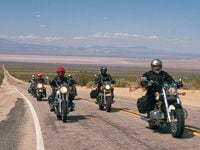
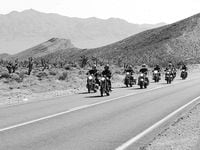
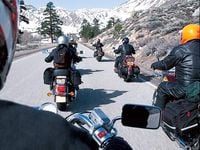
/cloudfront-us-east-1.images.arcpublishing.com/octane/H6Z2IC7WYRBXZNQS4MI3SZ5KPQ.jpg)
/cloudfront-us-east-1.images.arcpublishing.com/octane/IWO5T5PBT5E4HFQ5GK47H5YXR4.jpg)
/cloudfront-us-east-1.images.arcpublishing.com/octane/OQVCJOABCFC5NBEF2KIGRCV3XA.jpg)
/cloudfront-us-east-1.images.arcpublishing.com/octane/F3O2DGLA4ZBDJGNVV6T2IUTWK4.jpg)
/cloudfront-us-east-1.images.arcpublishing.com/octane/ZXYQE3MHLFDSPKNGWL7ER5WJ4U.jpg)
/cloudfront-us-east-1.images.arcpublishing.com/octane/RDF24VM7WVCOBPIR3V3R4KS63U.jpg)
/cloudfront-us-east-1.images.arcpublishing.com/octane/W7RSIBFISNHJLIJESSWTEBTZRQ.jpg)
/cloudfront-us-east-1.images.arcpublishing.com/octane/AERA26ENRNBW3K324YWCPEXYKM.jpg)
/cloudfront-us-east-1.images.arcpublishing.com/octane/YWX3YX7QBBHFXFDMEEEKRG4XJE.jpg)
/cloudfront-us-east-1.images.arcpublishing.com/octane/I7OKI53SZNDOBD2QPXV5VW4AR4.jpg)
/cloudfront-us-east-1.images.arcpublishing.com/octane/IH52EK3ZYZEDRD3HI3QAYOQOQY.jpg)
/cloudfront-us-east-1.images.arcpublishing.com/octane/K2FSAN7OWNAXRJBY32DMVINA44.jpg)
/cloudfront-us-east-1.images.arcpublishing.com/octane/G4XK7JL24FCUTKLZWUFVXOSOGE.jpg)
/cloudfront-us-east-1.images.arcpublishing.com/octane/JJNXVAC27ZCDDCMTHTQZTHO55Y.jpg)
